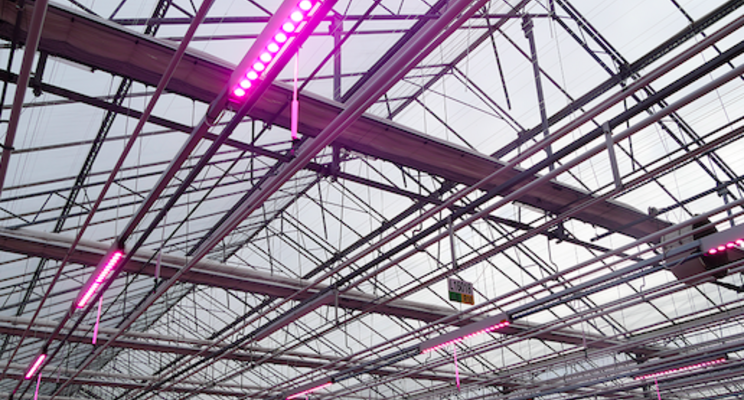Five tips to switch to LED lighting in your greenhouse
Added on 04 February 2022

When making the (partial) transition to LED, the choice can be made for significant energy savings on the one hand, or for raising the light intensity on the other. In both cases, next to selecting the right LED spectrum, you should keep the total cultivation set up in mind to make the transition successful. This includes factors such as plant density, irrigation, and plant variety, among others. HPS lighting creates radiation heat that LED lighting mostly lacks. The LED modules that are being applied most at the moment have an efficiency of 3,2 to 3,7 µmol light per joule electricity-input, and for HPS, with an efficiency of 1,8 µmol/J, this is 40 to 50% less.
Besides the factor of energy savings, this big difference has the advantage that the climate can be controlled better by steering the warmth and light separately. However, you as a grower should constantly be mindful to realize the right climate and cultivation conditions for the way in which the LED lighting is being applied. Naturally, there are big differences between cultivations, but there are several common factors as well.
Tip 1: Optimum Use of Your Lighting With Dimmable LEDs
Obviously, you will choose an LED spectrum with proven results for your crop. For many crops, the light recipe has been developed, and you can select from a database of more than 150 proven recipes. When HPS lighting is being replaced (partly) by LED, the total light level in the greenhouse usually increases significantly. In that case especially, it is useful to be able to dim the intensity of the LED lighting: with a dimmable installation you can respond to both the needs of the crop, weather conditions and the energy market, without making concessions to the uniformity of the light. An additional benefit of dimmable LEDs is that these become approximately 10% more efficient when dimmed. This decreases the energy usage per light unit.
Tip 2: Crop Activity Is the Key
Dividing the assimilates created by photosynthesis is an important consideration. It is a pitfall to have the plant absorb all the lighting with an artificial lighting installation, but neglect to create circumstances for the plant to distribute the assimilates to the parts of the plant where you would like them to go, which are often the fruits and/or the flowers. Without taking the appropriate actions, the crop could have too little evaporation, the plant temperature could stay too low, or it will absorb insufficient fertilizers.
Due to the absence of radiation heat, in some cultivations with LED screening is used more intensively and the windows stay closed more often to keep the heat inside the greenhouse. This can lead to a climate that is too passive, where the plant has problems evaporating. There are several options to keep the plant active. Key is the drainage of fluid around the plant. You can also consider extra air movement by fans, for example, or by adding a (minimal) heating pipe in combination with a gap in the screen, and possibly leaving the windows slightly open. Active dehumidification by air handling units for example, is also a perfect option in combination with LED lighting. In that way you can actively screen and dehumidify with limited energy input.
In many cases, we have seen that the energy saved by lighting with LED should be compensated slightly by a higher input of warmth. How much additional warmth input is needed differs strongly per crop situation, but the net energy savings compared to HPS are considerable when electricity and warmth are added. Moreover, in most situations, warmth also has a lower cost than electricity.
Tip 3: The Plant Rules
For optimal growth, the plant should always be leading. Eventually the crop will show to what level the light offered will be converted into the desired development. Keep an eye on the water absorption, developmental speed, etc., and adjust the climate accordingly to keep the crop balanced. For many crops, in order to make the plant use the created assimilates in the right way, you need to steer more generatively compared to HPS. Consider, for example, realizing a larger DIF, moisture balance, (leaf) pruning strategy, and adjusting the EC or recipe of nutrients where needed. For your crop, a greenhouse temperature of 68°F with HPS feels very different to 68°F with LED. That means that with LED, you should look more at the plant temperature instead of the surrounding temperature. It can also be a good idea to look at the plant temperature for the parts of the plant separately. When heat sources are applied differently, this can have influence the temperature of the roots and fruits for example, compared to the head of the plant. An example of this is that in high wire crops, the growth tubes are used much more with LED or hybrid lighting, to have a direct effect on the temperature of the fruits.
Click here to read more.
Photo Courtesy of Martin Stolze
Source: Greenhouse Grower
More news















